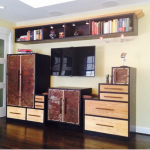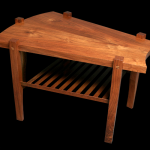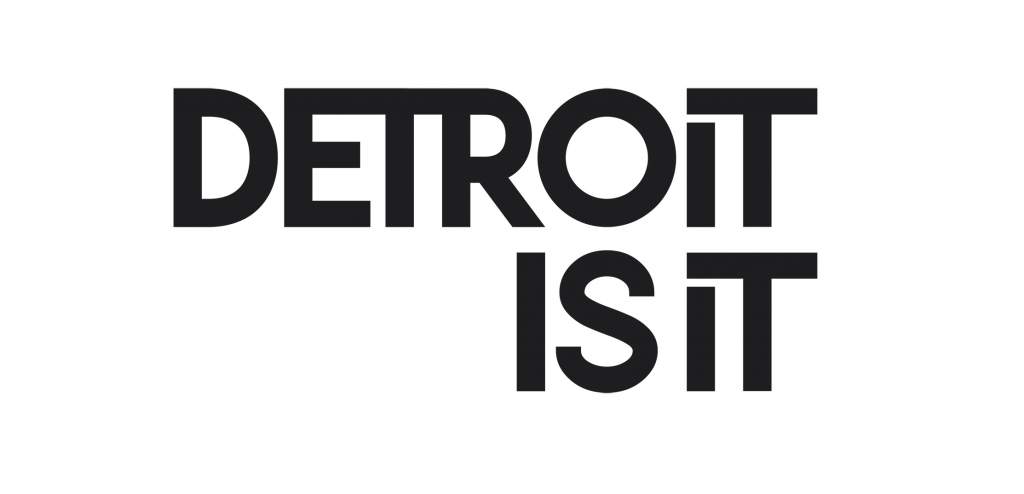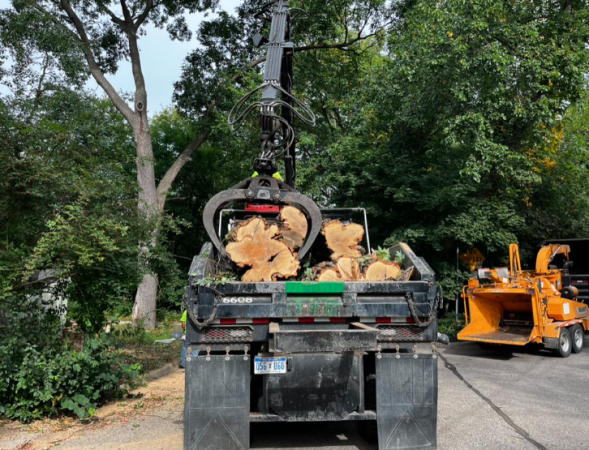Following the article on the Wright Museum’s partnership with the College for Creative Studies in which they repurposed three dying Zelkova trees in Detroit and created d.Tree Studio – a 15-week course on urban lumber, object making and story making – we bring you another story of the repurposing of urban lumber.
This one takes place largely in Ann Arbor.
According to Tiffany Giacobazzi, Ann Arbor urban forestry & natural resources planning coordinator of the Ann Arbor Forestry Department, the city of Ann Arbor loses about 600 trees per year. This reduces its carbon storage capacity dramatically.

ANN ARBOR BLACK LOCUST
Much of the loss sits within furniture-grade urban lumber, meaning the trees can be repurposed for furniture or other long-lived urban wood goods that aid in sequestering carbon, versus being used for mulch or firewood or being diverted to landfills.
Enter Paul Hickman, Founder and Owner of Urban Ashes, The Circular UrbanWood Triconomy™ (or the CUT Model™️), and founding member of the National Urban Wood Network.
According to Hickman, an estimated 64% of above-ground tree biomass in Michigan is merchantable, and the financial, social, and sustainable benefits derived from a circular economic system are great.
Further, in the state of Michigan alone, these annual benefits are estimated to be: 1.7 million tons of lumber; 1.26 million board feet of lumber; 1.54 million metric tons of carbon sequestered; $27.6 million USD; dozens of jobs, and many for returning citizens and youth that have had contact with the justice system.
Thus, Hickman founded Urban Ashes (UA). Boiled down, his purpose is to keep wood in use so that it can store carbon indefinitely. His other mission is to provide career and business opportunities for formerly incarcerated individuals and justice-impacted youth.

URBAN ASH CABINETRY BY PAUL HICKMAN
From 2009 to 2019 Hickman developed and grew the business to sell to 250+ retail partners across 43 states, repurposing urban lumber to create largely picture frames and furniture for retail. Much of his staff was formerly incarcerated individuals and justice-impacted youth.
Over time, the lack of wraparound (support) services (for workers) took a heavy toll. Eventually, he shifted entirely, shut down the manufacturing, and decided to focus on building the infrastructure to develop the supply chain more thoroughly and consistently and grow the markets for utilization as well as develop the critically needed wraparound services needed for our target labor pool.
So, he partnered with NextCycle Michigan and went through their FLOWS track which led to an EGLE grant. Then came the vision for the Circular UrbanWood Triconomy™, a circular economy built around urban wood utilization that focuses on businesses with a triple bottom line model.
Hickman, a resident of Ann Arbor, worked with University of Michigan graduate students for 18 months to validate the viability of the CUT model, and beginning in 2021, piloted it with the city of Ann Arbor.
“I had been talking with the city of Ann Arbor about doing something with the trees beyond mulch for a while,” said Hickman. “When Tiffany Giacobazzi came on as Ann Arbor urban forestry & natural resources planning coordinator of the Ann Arbor Forestry Department and the City created a sustainability office, I connected with her, and others, and we began to get serious.”

BLACK WALNUT WEDGE TABLE BY PAUL HICKMAN
Says Hickman, “The city does a great job of planting trees every year – up to 1,000 annually. But because the new trees are smaller and younger, it will take well over ten years of planting 1000 trees per year to catch up with the carbon lost in just year one.”
For years, all fallen urban trees in Ann Arbor (as is the case with most cities) were used for mulch or firewood. Accordingly, Ann Arbor loses approximately 1,111 metric tons of carbon every year.
Hickman was able to show them that by implementing the CUT Model™, upwards of 700 metric tons can be captured of that 1,111 and kept in use and sequestered.
“The CUT process involves cutting the trees down in a way that holds the most carbon and is best suited for the mills,” said Hickman. “The process also involves setting up the mills, facilities, contracts, and tracking methods.”
The wood is sold as raw lumber to manufacturing or local woodworkers and then used for items such as furniture, frames, ceiling/wall cladding, flooring, household trim packages, decorative pieces, and more.

URBAN FLAME BOX ELDER CHARCUTERIE BOARD
In addition to the Ann Arbor pilot, Hickman is talking with Grand Rapids, Detroit, Lansing, Traverse City, and several others outside of Michigan.
In closing, Hickman says, “My goal has always been to incorporate the highest utilization of urban lumber, the mass incarceration aspect, and local manufacturing and usage to help the local economy. I want to work toward those three ends. It has to come down to the human side. I think we fail tremendously in human impact. So, I’m not out to save the planet. I’m out to help save humanity for my kids and grandkids, and we need to include the planet and people to do that.”
As always, be sure to subscribe to our newsletter for regular updates on all things Detroit.




















